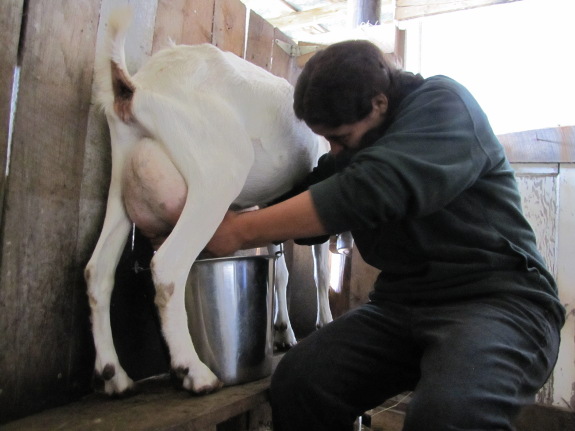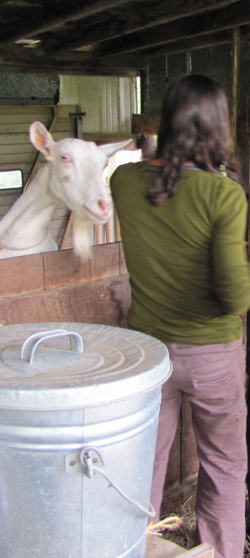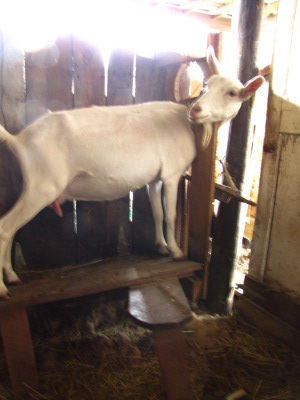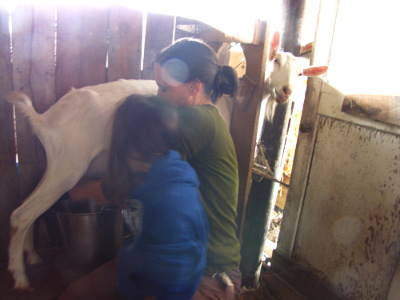
Learning to milk a goat

 I learned to milk a goat
Friday --- a huge thank you to Megan and
Erek, who took time
out of their hectic harvest-time schedule to give us personalized
attention! Thank you to the duo of Saanen does, too, who waited
an extra hour with full udders so that Mark and I didn't have to get up
quite so far before dawn. (And thank you to Mark, who continues
to humor my goat obsession, hoping I'll grow out of it.)
I learned to milk a goat
Friday --- a huge thank you to Megan and
Erek, who took time
out of their hectic harvest-time schedule to give us personalized
attention! Thank you to the duo of Saanen does, too, who waited
an extra hour with full udders so that Mark and I didn't have to get up
quite so far before dawn. (And thank you to Mark, who continues
to humor my goat obsession, hoping I'll grow out of it.)
Milking a goat is harder
than it looks, but I can tell that the knack is quite learnable.
Megan milked at the speed of light, and I managed to get some good
squirts after a while. Those goats were far more patient than I
deserve, due to a cup of sweet feed...and a head lock that kept them
from taking their noses out of the feed bowl.
One doe had slightly
smaller teats than the other, which made her much harder to milk for the
novice. Erek (Megan's husband) said that he wouldn't dream of
trying to milk a miniature
goat since the
problem would be exacerbated by the goat's diminutive size --- probably
the reason many miniature dairy goat owners use automatic milkers that
you can buy for a bit less than $200 apiece.
Megan estimates that it
takes her fifteen minutes to milk two full-size goats once a day
(turning in the kids after the morning milking so that they drink up
the other half of the daily milk.) That starts to answer one of
my questions --- whether keeping goats would take significantly more
time than just weedwhacking
our chicken pastures
a few times a year. (More number-crunching to come before I can
really answer that, though.)
 Megan
clued me in that the dream of feeding a dairy goat little or nothing
even if you only milk during the peak pasture season is just that...a
dream. If I'm remembering right, I believe that Megan said the
rule of thumb is a pound of grain per doe plus another pound per gallon
of milk produced. Otherwise, your poor goat will milk off all of
her fat and get skinny.
Megan
clued me in that the dream of feeding a dairy goat little or nothing
even if you only milk during the peak pasture season is just that...a
dream. If I'm remembering right, I believe that Megan said the
rule of thumb is a pound of grain per doe plus another pound per gallon
of milk produced. Otherwise, your poor goat will milk off all of
her fat and get skinny.
Next, Megan let me taste
some of the milk, which was a two-tiered test --- taste and ease on my
stomach. The taste test wasn't entirely fair because Megan had
left the milk out to come to room temperature so she could make cheese,
but I still thought it was quite tasty --- the slight aftertaste wasn't
enough to turn me off. That answers another question --- whether
the fancy dairy goat keepers who recommend you keep your goats off pasture so that the browse
doesn't impact the flavor of the milk are right. They probably
are if you have a highly advanced palate, but we'll eat
old chickens and
we'll also drink milk from a browsing goat.
 Over the last couple of
years, I stopped being able to drink grocery store cow's milk because
it began to make me queasy. I assumed I'd developed lactose
intolerance, but a bit more research turned up the factoid that what
most people of European descent call "lactose intolerance" is probably
a problem digesting certain proteins in the milk. Actual lactose
intolerance is more common among other ethnic groups. The
distinction is important because if you can't digest lactose, there's
no reason to try goat milk, but if you're having trouble with the
proteins in cow milk, you might not have a problem with the different
proteins in goat milk. Sure enough, Megan's milk sat lightly on
my stomach.
Over the last couple of
years, I stopped being able to drink grocery store cow's milk because
it began to make me queasy. I assumed I'd developed lactose
intolerance, but a bit more research turned up the factoid that what
most people of European descent call "lactose intolerance" is probably
a problem digesting certain proteins in the milk. Actual lactose
intolerance is more common among other ethnic groups. The
distinction is important because if you can't digest lactose, there's
no reason to try goat milk, but if you're having trouble with the
proteins in cow milk, you might not have a problem with the different
proteins in goat milk. Sure enough, Megan's milk sat lightly on
my stomach.
I had lots of fun, but
we made absolutely no decisions. Still lots more research to come
before we decide if goats are right for the farm.
Want more in-depth information? Browse through our books.
Or explore more posts by date or by subject.
About us: Anna Hess and Mark Hamilton spent over a decade living self-sufficiently in the mountains of Virginia before moving north to start over from scratch in the foothills of Ohio. They've experimented with permaculture, no-till gardening, trailersteading, home-based microbusinesses and much more, writing about their adventures in both blogs and books.
Want to be notified when new comments are posted on this page? Click on the RSS button after you add a comment to subscribe to the comment feed, or simply check the box beside "email replies to me" while writing your comment.
